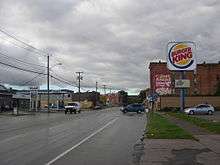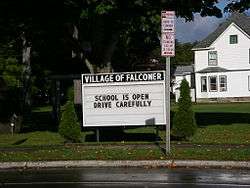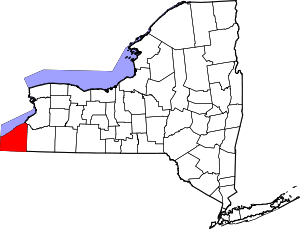Falconer, New York
| Falconer, New York | |
|---|---|
| Village | |
|
Sign on common | |
 Falconer Location within the state of New York | |
| Coordinates: 42°7′8″N 79°12′1″W / 42.11889°N 79.20028°WCoordinates: 42°7′8″N 79°12′1″W / 42.11889°N 79.20028°W | |
| Country | United States |
| State | New York |
| County | Chautauqua |
| Town | Ellicott |
| Area | |
| • Total | 1.1 sq mi (2.8 km2) |
| • Land | 1.1 sq mi (2.8 km2) |
| • Water | 0.0 sq mi (0.0 km2) |
| Elevation | 1,263 ft (385 m) |
| Population (2010) | |
| • Total | 2,420 |
| • Density | 2,214/sq mi (855.0/km2) |
| Time zone | Eastern (EST) (UTC-5) |
| • Summer (DST) | EDT (UTC-4) |
| ZIP code | 14733 |
| Area code(s) | 716 |
| FIPS code | 36-25164 |
| GNIS feature ID | 0949863 |
| Website |
falconerny |
Falconer is a village in Chautauqua County, New York, United States. The population was 2,420 at the 2010 census.[1] Falconer is within the town of Ellicott and is on the eastern edge of the city of Jamestown.
History
The town was originally called Worksburg, after Edward Work, who purchased the land from the Holland Land Company in August 1807. The first Falconer to own the land was Robert Falconer, who bought it from Edward Work in 1836. His son, Patrick, later consolidated his land holdings in the future village. In 1874 the community received its present name, after either William T. Falconer (1850–1915) or his father Patrick, who was on the Board of Directors of the Allegheny & Pittsburg Railroad and donated a large tract of land through town to the railroad concern. This resulted in the railroad line being routed through the middle of the community.[2]
The village of Falconer was incorporated in 1891.
John Cheever selected the village as the location for the fictional Falconer State Prison in his novel Falconer.
Geography
Falconer is located in the eastern part of the town of Ellicott at 42°7′8″N 79°12′1″W / 42.11889°N 79.20028°W (42.118908, -79.200207).[3] It is bordered to the west by the city of Jamestown, while its eastern tip touches the border of the town of Poland.
The Chadakoin River, the outlet of Chautauqua Lake, flows from Jamestown and passes through the village, meeting Cassadaga Creek to the northeast at Levant. The river system is part of the Mississippi River basin via Conewango Creek and the Allegheny River.
According to the United States Census Bureau, the village has a total area of 2.8 square kilometres (1.1 sq mi), all of it land.[1]

Demographics
| Historical population | |||
|---|---|---|---|
| Census | Pop. | %± | |
| 1890 | 574 | — | |
| 1900 | 1,136 | 97.9% | |
| 1910 | 2,141 | 88.5% | |
| 1920 | 2,742 | 28.1% | |
| 1930 | 3,579 | 30.5% | |
| 1940 | 3,222 | −10.0% | |
| 1950 | 3,292 | 2.2% | |
| 1960 | 3,343 | 1.5% | |
| 1970 | 2,983 | −10.8% | |
| 1980 | 2,778 | −6.9% | |
| 1990 | 2,653 | −4.5% | |
| 2000 | 2,540 | −4.3% | |
| 2010 | 2,420 | −4.7% | |
| Est. 2015 | 2,321 | [4] | −4.1% |
As of the census[6] of 2000, there were 2,540 people, 1,109 households, and 699 families residing in the village. The population density was 2,346 people per square mile (1454.5/km²). There were 1,216 housing units at an average density of 2,346.7 per square mile (906.1/km²). The racial makeup of the village was 97.8% White, 0.6% African American, 0.5% Native American, 0.3% Asian, 0.1% from other races, and 0.7% from two or more races. Hispanic or Latino of any race were 1.1% of the population.
There were 1,109 households out of which 29.4% had children under the age of 18 living with them, 46.5% were married couples living together, 11.7% had a female householder with no husband present, and 37.0% were non-families. 31.5% of all households were made up of individuals and 15.5% had someone living alone who was 65 years of age or older. The average household size was 2.29 and the average family size was 2.88.
In the village the population was spread out with 24.0% under the age of 18, 7.4% from 18 to 24, 27.0% from 25 to 44, 21.6% from 45 to 64, and 20.0% who were 65 years of age or older. The median age was 39.9 years. For every 100 females there were 92.7 males. For every 100 females age 18 and over, there were 86.1 males.
The median income for a household in the village was $32,222, and the median income for a family was $41,711. Males had a median income of $34,961 versus $21,250 for females. The per capita income for the village was $15,205. About 6.2% of families and 10.1% of the population were below the poverty line, including 13.1% of those under age 18 and 12.9% of those age 65 or over.
References
- 1 2 "Geographic Identifiers: 2010 Demographic Profile Data (G001): Falconer village, New York". U.S. Census Bureau, American Factfinder. Retrieved November 10, 2014.
- ↑
- ↑ "US Gazetteer files: 2010, 2000, and 1990". United States Census Bureau. 2011-02-12. Retrieved 2011-04-23.
- ↑ "Annual Estimates of the Resident Population for Incorporated Places: April 1, 2010 to July 1, 2015". Retrieved July 2, 2016.
- ↑ "Census of Population and Housing". Census.gov. Retrieved June 4, 2015.
- ↑ "American FactFinder". United States Census Bureau. Retrieved 2008-01-31.

